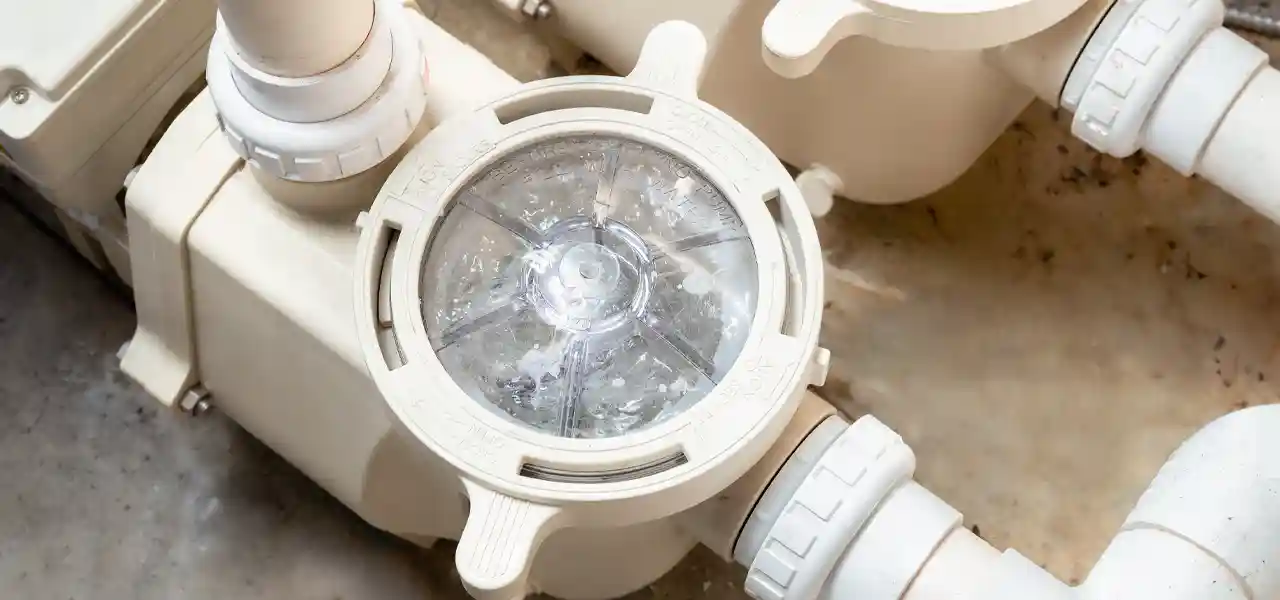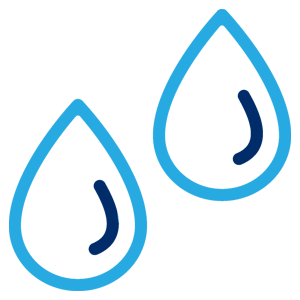FREE Standard Shipping On All Orders $100 or More!*

Pool Pump Troubleshooting Guide
Pool pumps are not overly complicated, but they can have complications. The heart of your circulation system, swimming pool pumps will need repair from time to time, to keep them operating in tip-top shape. Today, we'll cover the most common pool pump problems that pool owners deal with, and some solutions you can try to bring your pool pump back online, or prevent damage.
Pump Won't Turn On
When the pool pump ain't working, ain't nothing working. And it's an urgent problem, as you can only maintain the pool clarity for a few days without the circulation pump.
If the pump is silent...

If you hear no noise when you flip the switch to turn on, no sounds at all, check the circuit breaker for the pump, and flip it off and back on again. If the pump still won't turn on, check the time clock 'visual motor check' on Intermatic time clocks, to look for gears turning, indicating there is power supplied to the time clock. Above ground pumps plugged into an outlet can also check the GFCI test button, to be sure it hasn't popped.
If you are familiar with using a test meter, you can test the power at the switch, or time clock - and if power is reaching the switch or time clock, then you can remove the back of the motor and test the leads on the motor, to be sure that the same amount of voltage is reaching the pump motor.
If the pump is making a noise...

If you do hear a noise, like a buzz or hum coming from the motor, this is a sign that power is reaching the motor, but is having trouble starting the motor. Problems could be a bad capacitor, or centrifugal switch, or it could mean that the motor is 'frozen', from a buildup of internal rust. It could also mean that the impeller or fan is clogged. With power off, spin the motor shaft by hand, either by turning the impeller, or accessing the shaft at the rear of the motor (loosen the capacitor to gain access to shaft with a 7/16" wrench). If the shaft spins freely, look for a bulged or cracked capacitor, or loose wire connections, or a faulty centrifugal switch (screwed onto rear of motor shaft).
Pump Won't Shut Off
Not a normal occurrence, but if the pool pump won't shut off by the timer, have you got an 'OFF' dog on the timeclock (or two 'ON' dogs)? On some timeclocks, when the clock is within a 1/2 of turning on or off, the manual tab is blocked by the timer dog (tripper), and won't push to off. You can rotate the dial, or shut off the pump with the breaker. Does the timeclock dial spin, and keeping correct time? It may be bent, or not engaging the gear behind the timer dial. If you have just a switch, and not a timeclock, the pump not shutting off would be a faulty or mis-wired switch. Some two-speed pumps are meant to run all the time, on low speed for 18 hours daily, and high speed for 6 hours. Above ground pumps which plug into an outlet will also run 24 hours/day, unless a small plug-in timer is utilized.
Pump Won't Catch Prime

Many inground pool pumps have trouble from time to time getting the water moving. Some pumps need to be reprimed 3-4 times before they 'catch', so keep a bucket or garden hose handy. The most common source of pool pump not catching prime are air leaks before the impeller. Check that the pump lid is tight, with a lubed o-ring. Drain plugs should also be tightened with thread sealant. Most importantly, the threaded pipe that screws into the pump can shrink or become loose over time. Test it with shaving cream to see if the pump is sucking air around the incoming pipe fitting. If so, replumb the pump with a new fitting and thread sealant, or pack around the pump inlet with pool putty, and leave pump running for 24 hrs to allow putty to set up.
If not an air leak (prior to the pump), it could be an obstruction in the suction pipes (main drain / skimmer), or the pump basket or impeller (or both) could be clogged with small debris.. Finally, incoming directional valves or check valves can break (or just be closed), blocking water flow into the pump.
Pump Is Not Pumping Fully
If your pump is not running at 'full head', you can tell this by lower pressure on the filter gauge, and if you have a clear pump lid, you will see slow swirling water mixed with air. Pool pumps don't get 'tired', and lose their oomph over time - there is another problem at hand. As described above, check for air leaks in front of the pump, and look for any obstructions, clogged or blocked pipes or valves, before the pump. After the pump, obstructions or clogs will cause higher pressure on the filter, so if your low flow problem is coupled with high filter pressure, check the filter, filter valve and return side pipes and valves for clogs or obstructions.
Pump is Leaking Water
Pumps can leak water from many areas, but the prime suspects are the mechanical shaft seal and the effluent pipe fitting, the one that is screwed into the pump outlet. Check around the pipe fitting, to be sure the area is dry. If so, look under the pump to see exactly where the water is coming from. It will either be leaking out along the motor shaft (shaft seal failure), or it will be leaking where the seal plate connects with the volute, caused by a loose clamp band, or misaligned o-ring. In cases of freeze damage or a water hammer effect, some pumps will develops cracks in the volute or pump basket housing.
Pump Motor is Loud
Inside of your pump motor, the rotor spins within the stator, propelled to 3450 RPM by the alternating negative and positive attraction. On each end of the rotor shaft is a sealed bearing, pressed into place and removable with bearing pullers. Over time, usually 6-8 years, the bearings will wear out and begin to screech and shriek. Replacement of the bearings or replacing the motor is the solution to this problem. Other pump noises include cavitation, when the pump is starved for water due to a clog or closed valve. This sound is distinctly different from bad bearings, more of a low growling sound, or like the pump is gargling rocks.
Pump Motor is Rusty or Burned
Some pump motors can turn all sorts of colors from the heat generated by the motor, or hot spots on the windings. Pool pump motors run at around 150 degrees, too hot to touch, so a 'hot' motor can be considered normal. Burned spots or burned paint, or rusty motors may not indicate a problem with the motor, and can operate just fine internally, even when they don't look so hot externally. You can paint the motor if you wish, just tape over the label, and hit it with some black Rustoleum type paint.
Pump Motor is Overheating

Pump motors are designed with a Thermal Overload switch, located at 12:00 as you look at the back of the motor. If a motor overheats itself, the overload switch will shut off the motor for 10 minutes or so, and when the temperature reduces, you will hear the click (if you are close by and listening), as the switch resets itself. In most cases, an overheating motor has dead spots or hot spots on the windings and will need to be replaced with a new motor.
In some cases however, a motor may only overheat on very hot days with direct sunshine, or it may overheat from mulch or dirt built up around the motor vents. Fans or shade can help the first problem, and cleaning up around the pump (and maybe a chat with your landscaper) will solve the second problem.
Pump Housing is Cracked
Freeze damage from expanding ice inside the pump, or a water hammer effect caused by quickly closing off valves after the filter, or turning the filter multiport valve while the pump is running. The pump housing is also known as the volute or impeller housing. Pump housing could also refer to the hair & lint pot, or the pump basket housing. Either the pump pot or the volute can crack or warp from excessive heat. Replacement of the specific pump parts that are cracked is easily done, or the entire pump can be replaced, if the motor is also failing, or is more than 8 years old.
Pump Lid is Stuck
It's common that pool guys or homeowners really tighten down on the pump lid when screwing it on, in an effort to prevent air leaks around the pump lid o-ring. If you can't remove the pump lid, there are lid removal tools made specifically for the purpose, or you can make your own. I've seen homeowners carve a 2x4 with an internal opening that fits the raised part in the middle of a pump, but most pump lids have raised tabs on the sides of the raised middle part, and you can use a large screwdriver or a heavy bar or block of wood to use as a lever on the pump lid. And remember, lefty loosey, righty tighty - or turn it counter clockwise to remove the pump lid.
Pump Costs Too Much to Operate

In some parts of the country, pool pumps can cost a homeowner hundreds of dollars per month! Even small pumps in regions with cheaper electricity can rack up $50 per month in energy costs for the filter pump. Reducing hours of operation can save money, but don't sacrifice water quality, or you'll need to spend more money in chemicals to compensate. Many states now require all replacement pool pumps of 1hp or more to have either dual speed or variable speed motors. Dual speed motors also require a dual speed timeclock, to handle the additional fourth wire, the low speed wire. Hayward has released a new lower priced line of variable speed pumps, (around $750) - the Superpump VS and the Max-Flo VS pumps, can cut your electrical consumption by 70%, at 40% less cost than earlier generation Variable Speed models.